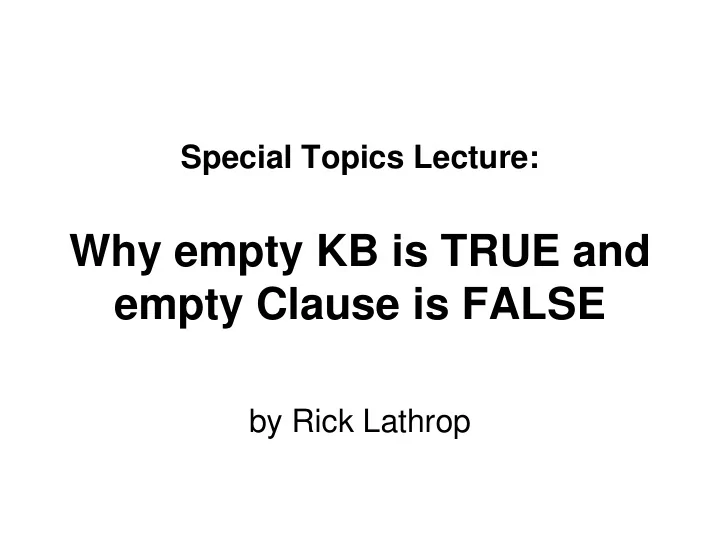

Special Topics Lecture: Why empty KB is TRUE and empty Clause is FALSE by Rick Lathrop
Notation used in this Special Topics lecture • Prefix notation (or extended Polish notation) – The operator appears first, followed by its arguments – (AND A B C) in prefix notation is (A AND B AND C) in infix notation (OR A B C) in prefix notation is (A OR B OR C) in infix notation – Prefix notation enables an easy parser it looks at the first element – of each list and dispatches args to a handler for that operator token. – Lisp and related languages define their entire syntax in prefix notation – See https: / / en.wikipedia.org/ wiki/ Polish_notation • Prefix allows any arity, delimited by (… ); strict Polish = fixed arity Conjunctive Normal Form (CNF) the AND of ORs • – KB = { AND (OR literal-1 literal-2 … ) (OR literal-3 literal-4 … ) … } Drop ANDs and ORs we know where they are (clausal notation) • – KB = { (literal-1 literal-2 … ) (literal-3 literal-4 … ) … } – In this lecture, KB uses { … } brackets, clauses use (… ) parentheses – Here, the empty KB { } always means { AND} with no clauses – Here, the empty clause () always means (OR) with no literals
Side Trip: Functions AND, OR, and identity values function AND( arglist ) returns a truth-value return ANDOR( arglist, TRUE) / * Think of AND as by default TRUE, but args may make it FALSE * / function OR( arglist ) returns a truth-value return ANDOR( arglist, FALSE) / * Think of OR as by default FALSE, but args may make it TRUE * / function ANDOR( arglist, identityvalue ) returns a truth-value / * identityvalue is TRUE for AND, and is FALSE for OR. * / if ( arglist = = NIL) then return identityvalue if ( FIRST( arglist ) = = NOT( identityvalue ) ) then return NOT( identityvalue ) return ANDOR( REST( arglist ), identityvalue ) So: AND() evaluates to TRUE and OR() evaluates to FALSE!
Side Trip: W e only need one logical connective. ( Note: AND, OR, NOT are “syntactic sugar” in logic.) Both NAND and NOR are logically com plete. – NAND is also called the “Sheffer stroke” – NOR is also called “Pierce’s arrow ” (NOT A) = (NAND A TRUE) = (NOR A FALSE) (AND A B) = (NAND TRUE (NAND A B)) = (NOR (NOR A FALSE) (NOR B FALSE)) (OR A B) = (NAND (NAND A TRUE) (NAND B TRUE)) = (NOR FALSE (NOR A B)) This fact is exploited by, e.g., VLSI semiconductor fabrication, which often provide a single NAND/ NOR gate for efficiency.
Review : KB | = S m eans | = ( KB ⇒ S) • KB | = S is read “KB entails S.” – Means “S is true in every world (model) in which KB is true.” KB | = S is equivalent to | = (KB ⇒ S) • | = (KB ⇒ S) means “(KB ⇒ S) is true in every world (i.e., is valid).” – | = (KB ⇒ S) means TRUE | = (KB ⇒ S) means { } | = (KB ⇒ S) – And so: { } | = S is equivalent to | = ({ } ⇒ S) • So what does ({ } ⇒ S) mean? • – Means “TRUE implies S.” – Means “S is valid.” – In Horn form, means “S is a fact.” p. 256 (3 rd ed.; p. 281, 2 nd ed.) • W hy does { } m ean TRUE here, but ( ) m eans FALSE in resolution proofs?
Review : ( TRUE ⇒ S) m eans “S is a fact.” • By convention, – The null conjunct is “syntactic sugar” for TRUE (see above slides). – The null disjunct is “syntactic sugar” for FALSE (see following slides). Each is assigned the truth value of its identity elem ent. – • For conjuncts, TRUE is the identity: (A ∧ TRUE) ≡ A • For disjuncts, FALSE is the identity: (A ∨ FALSE) ≡ A • A KB is the conjunction of all of its sentences. – So we see that { } is the null conjunct and means TRUE. – Better way to think of it: { } does not exclude any worlds (models) because nothing falsifies the dominant connective AND . • In Conjunctive Normal Form each clause is a disjunct. – So we see that ( ) is the null disjunct and means FALSE. – Better way to think of it: ( ) does not include any worlds (models) because nothing satisfies the dominant connective OR .
Recommend
More recommend